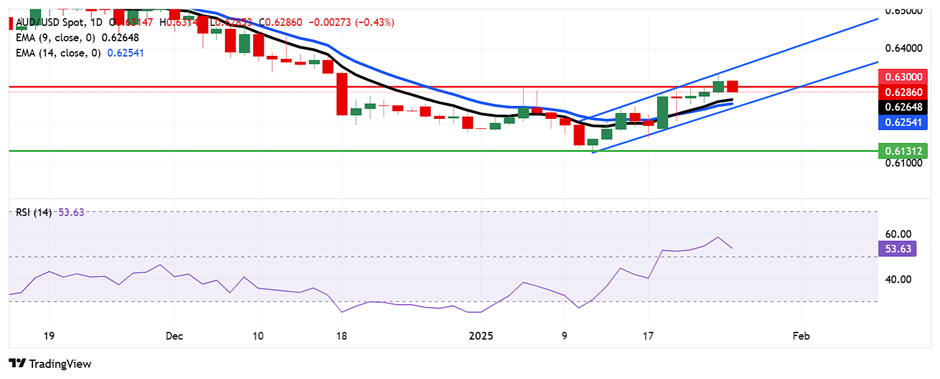Australian Dollar remains subdued following China’s PMI, fresh stimulus measures

The Australian Dollar holds losses following the mixed Chinese Purchasing Managers' Index data release.
The China Securities Regulatory Commission has approved a second round of long-term stock investment pilot programs valued at $7.25 billion.
The USD strengthens amid uncertainty surrounding the impact of US President Donald Trump's trade and immigration policies.
The Australian Dollar (AUD) ends its three-day winning streak against the US Dollar (USD), with the AUD/USD pair trading subdued following the release of mixed Chinese Purchasing Managers' Index (PMI) data on Monday. As close trade partners, China's economic performance significantly impacts the Australian economy.
China's NBS Manufacturing PMI fell to 49.1 in January, down from 50.1 in December, missing the market expectation of 50.1. Similarly, the NBS Non-Manufacturing PMI declined to 50.2 in January compared to December's 52.2 reading.
The Australian Dollar also failed to gain support from China’s fresh stimulus measures to promote its development of index investment products, its latest effort to revive the ailing equity market. The China Securities Regulatory Commission (CSRC) has approved a second round of long-term stock investment pilot programs valued at 52 billion Yuan ($7.25 billion).
China’s Industrial Profits declined by 3.3% year-over-year to CNY 7,431.05 billion in 2024, easing from the 4.7% drop recorded in the first 11 months of the year. This marks the third consecutive year of contraction, following a 2.3% decline in 2023. The continued downturn reflects ongoing economic challenges, including weak demand, rising deflationary pressures, and a prolonged slump in the property sector.
Australian Dollar declines due to increased risk aversion regarding Trump’s policies
The US Dollar Index (DXY), which tracks the value of the US Dollar against six major currencies, has rebounded from its monthly low of 107.22 recorded on Friday. The DXY trades near 107.60 at the time of writing.
The USD gains strength amid uncertainty regarding the impact of US President Donald Trump's trade and immigration policies. This backdrop may encourage the Federal Reserve (Fed) to maintain a cautious stance on cutting interest rates this year.
According to S&P Global data released on Friday, the US Composite PMI fell to 52.4 in January from 55.4 in December. The Manufacturing PMI rose to 50.1 in January, surpassing the previous reading of 49.4 and exceeding the forecast of 49.6. However, the Services PMI dropped to 52.8 in January from 56.8 in December, falling short of the expected 56.5.
However, Trump said on Thursday that he wants the Fed to cut interest rates immediately. "With oil prices going down, I'll demand that interest rates drop immediately, and likewise they should be dropping all over the world," said Trump at the World Economic Forum in Davos, Switzerland.
The US Dollar faced challenges as Trump's remarks came before the Federal Reserve's (Fed) monetary policy meeting scheduled for January 28 and 29, with expectations the US central bank will hold rates steady.
Traders expect the Fed to keep its benchmark overnight rate steady in the 4.25%-4.50% range at its January meeting. Moreover, Trump’s policies could drive inflationary pressures, potentially limiting the Fed to just one more rate cut.
President Trump has imposed an emergency 25% tariff on all Colombian goods entering the United States (US), with plans to raise it to 50% within a week. The move comes after Colombia refused to permit two US military planes carrying deported migrants to land. A White House official, speaking to Reuters on Sunday, stated that the measure was intended to serve as a warning to other nations about the consequences of rejecting deportation flights.
Australia’s Judo Bank’s Composite Purchasing Managers Index (PMI) edged higher to 50.3 in January, up from 50.2 in December. Meanwhile, Manufacturing PMI climbed to 49.8 in January from 47.8 in December, the highest reading in 12 months, breaking a streak of 13 consecutive months of contraction. However, the Services PMI dipped to 50.4 from 50.8, hitting a six-month low and indicating a slowdown in the sector's growth.
President Trump expressed optimism, stating that he "would rather not have to use tariffs on China" and is hopeful about reaching a deal. Trump's remarks came after his conversation with China’s President Xi Jinping on Thursday, hinting at potential progress in US-China trade negotiations.
Chinese authorities introduced several measures on Thursday to stabilize its stock markets, including allowing pension funds to increase investments in domestic equities. A pilot scheme enabling insurers to purchase equities will be launched in the first half of 2025, with an initial scale of at least 100 billion Yuan. Meanwhile, the People’s Bank of China (PBoC) said that they “will expand the scope and increase the scale of liquidity tools to fund share purchases at the proper time.”
Technical Analysis: Australian Dollar could retest ascending channel’s upper boundary at 0.6350
The AUD/USD pair trades near 0.6290 on Monday, showing upward movement within an ascending channel on the daily chart, hinting at a potential bullish bias. The 14-day Relative Strength Index (RSI) remains slightly above 50, supporting positive market sentiment.
On the upside, the AUD/USD pair could retest the key psychological resistance at 0.6300, with the next target near the channel's upper boundary around 0.6350.
Initial support is located at the nine-day Exponential Moving Average (EMA) of 0.6265, followed by the 14-day EMA at 0.6254. A stronger support lies near the channel's lower boundary around 0.6240.
AUD/USD: Daily Chart
Australian Dollar PRICE Today
The table below shows the percentage change of Australian Dollar (AUD) against listed major currencies today. Australian Dollar was the weakest against the Japanese Yen.
| USD | EUR | GBP | JPY | CAD | AUD | NZD | CHF | |
|---|---|---|---|---|---|---|---|---|
| USD | 0.33% | 0.29% | -0.02% | 0.21% | 0.49% | 0.47% | 0.16% | |
| EUR | -0.33% | 0.03% | -0.20% | 0.02% | 0.16% | 0.26% | -0.06% | |
| GBP | -0.29% | -0.03% | -0.54% | -0.00% | 0.13% | 0.25% | -0.09% | |
| JPY | 0.02% | 0.20% | 0.54% | 0.26% | 0.67% | 0.72% | 0.32% | |
| CAD | -0.21% | -0.02% | 0.00% | -0.26% | 0.07% | 0.26% | -0.08% | |
| AUD | -0.49% | -0.16% | -0.13% | -0.67% | -0.07% | 0.14% | -0.18% | |
| NZD | -0.47% | -0.26% | -0.25% | -0.72% | -0.26% | -0.14% | -0.55% | |
| CHF | -0.16% | 0.06% | 0.09% | -0.32% | 0.08% | 0.18% | 0.55% |
The heat map shows percentage changes of major currencies against each other. The base currency is picked from the left column, while the quote currency is picked from the top row. For example, if you pick the Australian Dollar from the left column and move along the horizontal line to the US Dollar, the percentage change displayed in the box will represent AUD (base)/USD (quote).
Australian Dollar FAQs
One of the most significant factors for the Australian Dollar (AUD) is the level of interest rates set by the Reserve Bank of Australia (RBA). Because Australia is a resource-rich country another key driver is the price of its biggest export, Iron Ore. The health of the Chinese economy, its largest trading partner, is a factor, as well as inflation in Australia, its growth rate and Trade Balance. Market sentiment – whether investors are taking on more risky assets (risk-on) or seeking safe-havens (risk-off) – is also a factor, with risk-on positive for AUD.
The Reserve Bank of Australia (RBA) influences the Australian Dollar (AUD) by setting the level of interest rates that Australian banks can lend to each other. This influences the level of interest rates in the economy as a whole. The main goal of the RBA is to maintain a stable inflation rate of 2-3% by adjusting interest rates up or down. Relatively high interest rates compared to other major central banks support the AUD, and the opposite for relatively low. The RBA can also use quantitative easing and tightening to influence credit conditions, with the former AUD-negative and the latter AUD-positive.
China is Australia’s largest trading partner so the health of the Chinese economy is a major influence on the value of the Australian Dollar (AUD). When the Chinese economy is doing well it purchases more raw materials, goods and services from Australia, lifting demand for the AUD, and pushing up its value. The opposite is the case when the Chinese economy is not growing as fast as expected. Positive or negative surprises in Chinese growth data, therefore, often have a direct impact on the Australian Dollar and its pairs.
Iron Ore is Australia’s largest export, accounting for $118 billion a year according to data from 2021, with China as its primary destination. The price of Iron Ore, therefore, can be a driver of the Australian Dollar. Generally, if the price of Iron Ore rises, AUD also goes up, as aggregate demand for the currency increases. The opposite is the case if the price of Iron Ore falls. Higher Iron Ore prices also tend to result in a greater likelihood of a positive Trade Balance for Australia, which is also positive of the AUD.
The Trade Balance, which is the difference between what a country earns from its exports versus what it pays for its imports, is another factor that can influence the value of the Australian Dollar. If Australia produces highly sought after exports, then its currency will gain in value purely from the surplus demand created from foreign buyers seeking to purchase its exports versus what it spends to purchase imports. Therefore, a positive net Trade Balance strengthens the AUD, with the opposite effect if the Trade Balance is negative.
* The content presented above, whether from a third party or not, is considered as general advice only. This article should not be construed as containing investment advice, investment recommendations, an offer of or solicitation for any transactions in financial instruments.



